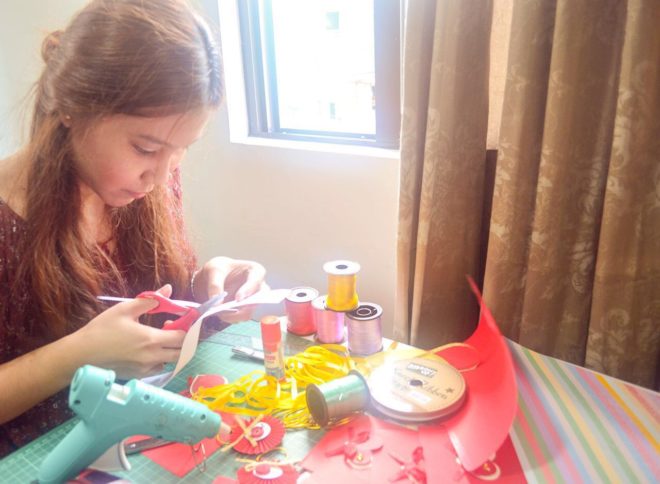[ventuno id=’MCsxMDU2MzgwfHwyMzY4fHwxMDg2fHwxLDIsMQ==’][/ventuno]
For 27-year-old entrepreneur Christine Marie Bowman, the holiday season is a time to tell her loved ones how much they mean to her. And she expresses this not just by giving gifts, but also by sending them traditional greeting cards.
Bowman, owner of online arts and crafts shop Handmade Cards, has been making and selling greeting cards for three years now to help others convey their personal thoughts and wishes to someone.
“In these digital days, nothing beats the traditional way of giving cards for Christmas because receiving a card means someone actually gave effort and thought to it. How much more for [a] handmade card with a touch of dedication, passion, and art,” Bowman said in an e-mail interview with INQUIRER.net.
She makes customized handmade cards for all occasions and sells it on her Facebook page.
Albeit a rare custom these days especially among people her age, Bowman said giving out greeting cards is an effective way of making someone “feel important and valuable” because of the sender’s message written inside it.
While it is not as popular in the Philippines as with the United States, card-giving remains a practice among some Filipinos, especially among the older generation, who prefers to add a personal touch to their gifts or simply tell someone they care.
Wilting tradition
But admittedly, the practice of card-giving among Filipinos has waned with the rise of the Internet.
Malou Posadas, Assistant Vice President for Product Management of Filstar Distributors Corp., the exclusive licensee of Hallmark Philippines, said the technology has definitely made a huge impact to the company as people now can easily greet everyone through social media – a medium that is convenient and free.
“There’s a decline [in sales]. Actually flat [sales] ngayon e. Siguro from 10 years ago, dun talaga namin na, slowly, naramdaman ‘yung effect ng social media,” Posadas told INQUIRER.net in an interview.
(Actually there’s a flat in sales. Maybe, about 10 years ago, was when we slowly felt the effect of social media.)
“It started with text message, SMS. That’s when we started to get hit—35-peso card versus a one-peso text message or SMS that’s very convenient, just by phone, you’re able to do what you need to do without going to the bookstore and buying and sending the card,” she added.
Before, Hallmark Philippines prints about 460 designs per year—now, it only prints about 200, mostly the best-sellers, to adapt with the society’s shift to digital age. It has also moved to selling other products such as gift bags, wraps, and tags.
Interestingly, however, Hallmark Philippines’ sales from greeting cards still make up 20 percent of the brand’s overall revenues—a trend that Posadas sees as a sign that the card-giving tradition is here to stay.

Keeping up with the times
Keeping the card-giving practice alive in the era of smartphone and social media is definitely a challenge, said Julienne Dedoro, brand officer of Hallmark Philippines. The brand has to innovate in terms of designs and sentiments—or the message written in the card—to make it more relevant to Filipinos, especially the younger generation.
In 2016, the brand launched lesbian, gay, bisexual, and transgender (LGBT) cards to celebrate all kinds of relationships. It has also come up with cards written with humorous sentiments for mothers, as well as cards with three-dimensional and pop-up designs.
“We try to cope up with designs, a different take on the sentiments, for us to penetrate the younger market,” Dedoro said.
“That’s key—innovation. You have to release products that are new to the market every now and then,” Posadas added.
Staying on
Posadas, Dedoro, and Bowman are confident that despite the fast-changing technology, the tradition will not die and will continue to be a practice as it “emotionally connects” two people through thoughts and sentiments.
“It’s more sincere. Because when you say happy birthday through phone, it’s a mere greeting. Unlike when you sent a card, there’s [an] effort in looking for the perfect card for the recipient. There’s a personal touch to it,” Posadas said.
“For you to give the card, you have to also invest your thoughts or your feelings, what you want to convey to the recipient. It’s not just picking up a card from the racks—you have to spend time, effort, and think what you want tell them,” Dedoro noted.
Bowman, for her part, believes that card-giving “will continue to exist” in the digital world as there are still people “who want to express themselves in the traditional way.”
“Seeing people happy knowing that the gift was given thought, effort and time is the greatest joy we could give to them. Giving someone a handmade card makes the person feel important and valuable by the time when he/she receives it,” she said. /kga
Originally posted 10:38 am | Dec. 22, 2017

